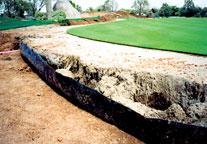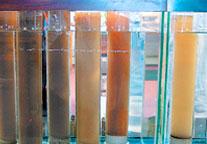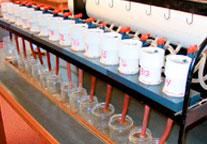"Building a Better Green" (Golfdom: August 1, 2005)
August 1, 2005
By: Sarah Willnerd
Golfdom
 With all of the different construction products and techniques that have come to the forefront in the past few years, superintendents are faced with myriad choices when constructing greens. In turn, they often look to the United States Golf Association (USGA) for clear guidance on how to construct a quality green.
With all of the different construction products and techniques that have come to the forefront in the past few years, superintendents are faced with myriad choices when constructing greens. In turn, they often look to the United States Golf Association (USGA) for clear guidance on how to construct a quality green.
"When you're writing guidelines being used as specifications, you can't go with something you think works some of the time, but you know doesn't work some of the time," says Jim Moore, the USGA's director of construction education. "You stick very strongly by what you're sure works."
In its ongoing efforts to assist superintendents in determining the best products for their courses, the USGA in 1993 and 2004 made its most significant changes to its "Recommendations for a Method of Putting Green Construction" by broadening categories that define what and how materials can be used to construct greens. The changes were made to accommodate the fast-evolving technology in course materials and construction methods and to address issues relating to testing on certain construction materials and methods.
The USGA, while acknowledging that all greens are different and that one solution does not fit all, says it will seek to eliminate the "unknowns" of green construction by continually testing new technologies and materials for quality and performance.
Industry standard
 Initially created in 1960, the USGA recommendations have been the industry standard as well as the most widely used method of green construction throughout the United States and internationally. Prior to the 2004 amendment, the recommendations were revised in 1965, '73, '82, '89 and '93. The revisions were made to ensure that the success and performance of greens keep up with the many new challenges of green maintenance. Adding to these challenges has been the evolving technology that seeks to improve the quality of the soil and reduce the costs to construct greens.
Initially created in 1960, the USGA recommendations have been the industry standard as well as the most widely used method of green construction throughout the United States and internationally. Prior to the 2004 amendment, the recommendations were revised in 1965, '73, '82, '89 and '93. The revisions were made to ensure that the success and performance of greens keep up with the many new challenges of green maintenance. Adding to these challenges has been the evolving technology that seeks to improve the quality of the soil and reduce the costs to construct greens.
With its emphasis on research, the USGA has funded more than $1 million of research on course constructions since the last recommendation changes in 1993. Seeking to evolve with the technological changes and to address  superintendents' concerns on the undetermined performance of several new products on the market, the USGA made its first efforts to specifically broaden certain recommendations in 1993.
superintendents' concerns on the undetermined performance of several new products on the market, the USGA made its first efforts to specifically broaden certain recommendations in 1993.
These changes to include new construction methods and materials were intended to make the process of building greens easier and more cost-effective and sought to provide greater flexibility in construction. The changes were all made with the caveat that the greens had to be properly tested and approved for USGA-standard quality and consistency.
One of the most significant changes occurred when the USGA altered the dynamics in course construction to mirror what more builders and architects were successfully using and to make new course constructions more cost effective. The change was to include the option to omit the intermediate or "choker" layer. Moore says this was the biggest change the USGA had ever made to its guidelines.
"(The intermediate layer) is very difficult and expensive to put in, and prior to 1993 the USGA insisted it be in the greens," Moore adds. Some greens were built without the layer and performed fine, he adds. Some greens were built without the choker layer and failed — their rootzone mixtures moved down into their gravel layers.
"But now, when people choose to build greens to USGA guidelines, they have the option of including the layer or leaving it out, depending on the makeup of their construction materials," Moore says. "Prior to 1993, we would tell you that you did not have a USGA green if you didn't have that layer in there."
The 2004 changes
By 2003 enough empirical evidence and research had come forth to mandate the recommendations be changed again. With 18 possible revisions, the USGA organized and sent the revisions through more than 200 people, including architects, agronomists, engineers and trade professionals, and several committees before determining six revisions were necessary.
These revisions included simplifying saturated hydraulic conductivity, widening the tolerance of the rootzone depth, widening the specifications for gravel size, increasing the coefficient of uniformity for gravel, allowing for the use of flat pipe with certain specifications, and allowing for the use of inorganic amendments in green construction, pending approval of the final rootzone mixture by the physical soil testing laboratory.
The inclusion of inorganics to the 2004 recommendations is one example of the USGA's efforts to broaden definitions of the materials used to construct a USGA-quality green while addressing concerns about the performance of products whose performance tests have been determined to be inconclusive.
Specifically excluded prior to 2004, porous inorganic amendments such as calcined clays (porous ceramics), calcined diatomites and zeolites were added to the 2004 recommendations. While those changes do allow for the use of inorganics in the greens mix as long as they meet the particle size and performance criteria of the mix, the recommendations also caution that users should be aware of the differences in products and that conclusive testing on the performance of the inorganics was not prevalent.
To be sure, some in the golf course construction industry believe a sand/peat rootzone mix is the best mix for green construction. However, field evidence of greens that have mixed in inorganics has shown to also work well.
The bottom line, however, is that superintendents are ultimately responsible for how their courses' greens perform.
"By far, the greatest variable in how greens perform is the turfgrass manager," Moore says. "That far outweighs the construction of the green. I've visited superintendents in some climates who seemed to be able to grow grass on concrete in full shade. I've visited others that have everything going for them, and they still have problems."
Moore said climate, the method of how a green is constructed, the type of materials used in the construction and the varying managing ability of superintendents all have influences on how a green performs. Moore says that adding an inorganic to the mix doesn't necessarily mean it will perform better.
"If we build a golf course in full sun, with full air movement, no traffic, it's in Colorado where we don't get any real disease pressure and we build the green like the back of a turtle so we have great surface drainage — it's practically a given the green is going to perform well," Moore adds.
Recent side-by-side test results have also provided additional insight and guidance to the options that superintendents have today in constructing an agronomically sound rootzone.
In a recent Ohio State University study, the use of inorganic amendments was shown to significantly improve sand-based rootzones' nutrient retention and prevent soluble nutrients from leaching and polluting the environment. Such research has been invaluable in assisting superintendents to determine the best mix and techniques.
Of course, some superintendents will rely on tried-and-true experience to determine what materials and construction techniques will work best. Ed Seay, executive vice president and chief operating officer with Arnold Palmer Golf Courses, is a proponent of using an inorganic, porous ceramic in all Palmer courses. Seay recommends their use because in his experience they've provided superintendents with reliably positive results.
"Every spec we send out has porous inorganic amendments included," he says. "The grass grows better and more consistent and it gives a stable, solid rootzone."
Ideally, the best research for a superintendent and his or her golf course's performance will be detailed studies conducted on his or her course. Even with the broadening of the recommendations, many believe that much research still needs to be done to accommodate new technologies, alternative materials and cultural practices to achieve the best courses possible.

